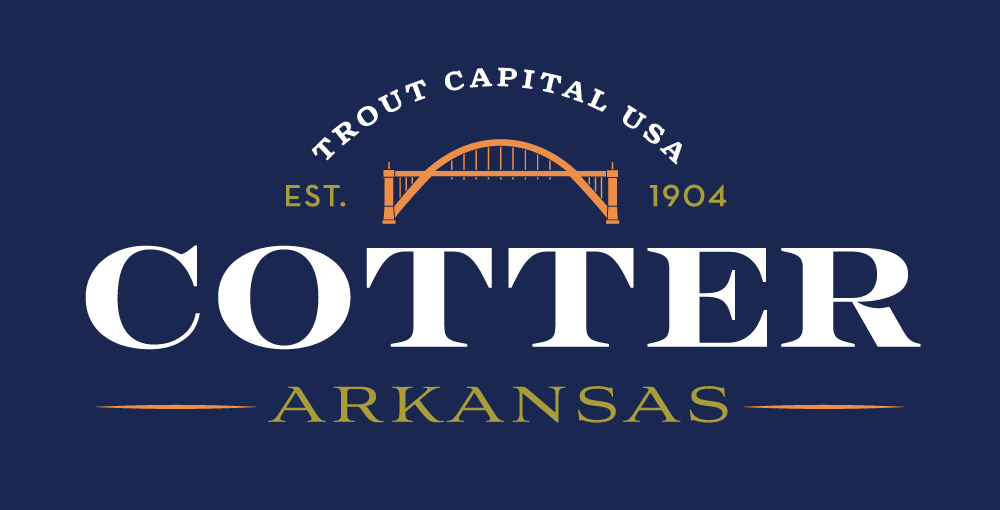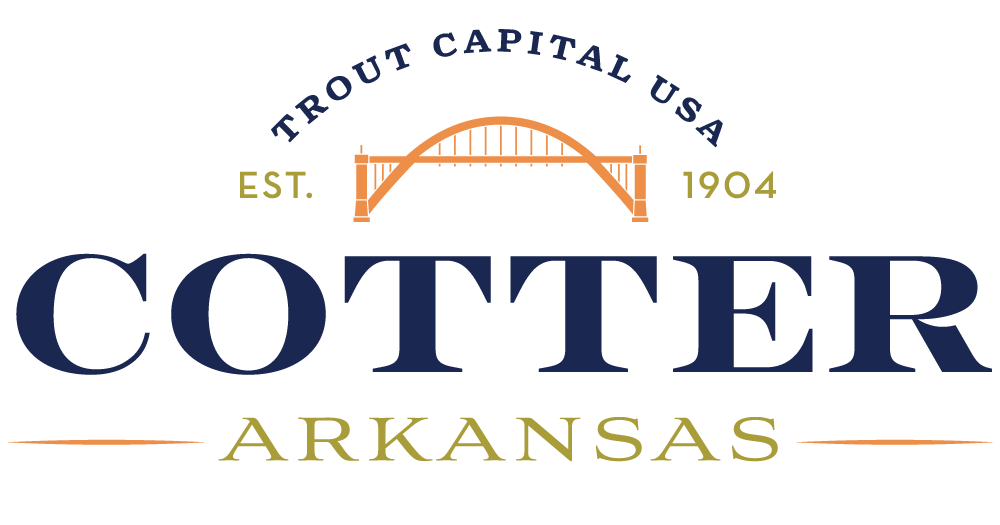History of Cotter Arkansas
The story of Cotter begins long before its official founding, with evidence suggesting that bluff dwellers inhabited the area's caves and rock shelters. Indigenous people knew this region as the "Province of Coligoa." One early recorded encounter with Europeans occurred in 1543 when the explorer Hernando de Soto and his group were reportedly welcomed by Chief Ozarkus near what is now Big Spring Park. Centuries later, in 1829, the tragic westward journey of the Cherokee people along the Trail of Tears passed through this land, and today, historic markers in Cotter serve as a reminder of this significant event.
A pivotal moment in Cotter's more recent history came in 1868 when Jonathan Cunningham first homesteaded a large tract of land. This property was later acquired by L.P. Kemp in 1883. At that time, the White River was crossed by Lake's Ferry, a unique river-powered ferry located downstream from where the iconic Rainbow Arch Bridge now stands.
The vision for the town of Cotter began to take shape with the Red Bud Realty Company, incorporated in 1903. Key figures in this company, W.V. Powell, Jerry South, and Thomas Combs, are still remembered today as several of Cotter's streets bear their names.
The true birth of Cotter was driven by the arrival of the St. Louis, Iron Mountain & Southern Railroad, which later became part of the Missouri Pacific system. As the railroad laid tracks between Newport and Carthage, Missouri, the White River in Baxter County proved to be an ideal central location for a division point. The town was named in 1904 to honor William Cotter, a civil engineer and Railroad Manager on the project. The official opening of the City of Cotter followed on November 23, 1905.
The opening of Cotter was a momentous occasion, drawing an estimated 4,000 people, a remarkable number that dwarfed the town's population at the time. This enthusiastic beginning reflected the excitement surrounding the arrival of the railroad and the promise of a new Ozark town.
Today, Cotter offers a peaceful yet historically rich experience for both residents and visitors. Nestled on a bend of the White River in northern Arkansas, it remains a family-oriented community that cherishes its natural surroundings and the recreational opportunities of the Ozarks.
*CLICK ON PHOTOS TO VIEW IN A FULL VIEW SLIDESHOW.
Historic Cotter Rainbow Bridge

The Cotter Bridge, officially known as the R.M. Ruthven Bridge in honor of the County Judge, stands as a significant historical landmark for Cotter. This impressive structure is believed to be the largest remaining bridge of its kind. Designed by the Marsh Engineering Company, the Cotter Bridge utilizes a reinforced-concrete rainbow arch design patented by James Marsh in 1912.
Construction of the six-span bridge was undertaken by the Bateman Contracting Company of Nashville, Tennessee, in 1929, at a cost of approximately $500,000. Spanning around 1,850 feet, it quickly became a vital transportation link in the region.
After serving the community for seventy-three years, the bridge underwent a restoration project beginning in 2002. Forty-four dedicated workers labored on this endeavor, and despite some delays, the restoration was completed in 2004. The newly revitalized bridge was celebrated with a grand illumination on December 13, 2004, featuring more than 3,000 lights that highlighted its architectural beauty.
The re-dedication ceremony on September 24th was a memorable event. It commenced with the national anthem and a flyover by three vintage aircraft from Cotter’s “Air Force” during the Valley Fly-In. At 3:00 p.m., a cannon fired to mark the official reopening of the R.M. Ruthven Bridge. War re-enactors from Mountain Home and Bakersfield, Missouri, added to the spectacle by firing a 12-pound Napoleon cannon, synchronized with water arches from the Cotter Fire Department. The ribbon-cutting was performed jointly by Cotter Mayor Bill Jennings and Flippin Mayor Mary Jane Erwin.
Following the ribbon cutting, a procession of ten vintage cars, including a 1923 Buick Roadster, a 1926 Ford Phaeton, and a 1929 Desoto, crossed the bridge. Speakers at the event included Bill Jennings, Wayne Ruthven, Forrest Wood, and Jonathan Barnett. A poem dedicated to the bridge's builders and restorers, written by Herbert Messick, was read by his daughter Mary Ann Messick.
Beyond its historical significance and striking rainbow arch design, the Cotter Bridge offers breathtaking views of the White River below. This stretch of the river is renowned for its exceptional trout fishing, attracting anglers seeking rainbow, brown, brook, and cutthroat trout, as well as other species like jack salmon, buffalo, red-horse suckers, and catfish. Whether one enjoys fly fishing, spin casting, or traditional angling, the White River beneath the historic Cotter Bridge promises a memorable experience.
*CLICK ON PHOTOS TO VIEW IN A FULL VIEW SLIDESHOW.
Anglin-Tinnon Railroad Workers Memorial
The Anglin-Tinnon Railroad Workers Memorial honors Cotter’s railroad history and the workers who lived it. At the entrance to the memorial grounds is a black granite monument that highlights the founders and four railroad emblems: Missouri Pacific Iron Mountain, Missouri Pacific, Union Pacific, and M&NA (Missouri and North Arkansas); an engraving of a locomotive is on the back.
*CLICK ON PHOTOS TO VIEW IN A FULL VIEW SLIDESHOW.
Walnut Hill Cemetery
The Walnut Hill Cemetery, also referred to as the Cotter Cemetery, is situated off the west end of Walnut Hill Lane, near U.S. Highway 62, within the City of Cotter.
Established in 1905, coinciding with the town's founding by the Missouri Pacific Railroad, the Walnut Hill Cemetery serves as the final resting place for many of Cotter's residents. The City of Cotter is responsible for the upkeep and maintenance of the cemetery grounds and also manages the sale of burial plots. For those seeking information or records related to the cemetery, these are on file in the Recorder-Treasurer’s Office at the City Hall.
*CLICK ON PHOTOS TO VIEW IN A FULL VIEW SLIDESHOW.
Cotter Walnut Hill Cemetery Maintenance & Restoration
The Saturday Club, in partnership with the City of Cotter, would like to inform the public about Ordinance 2020-03, which outlines the rules, regulations, and fees for grave spaces in Cotter Walnut Hill Cemetery. Copies of this ordinance are available at City Hall.
As we move forward in the Restoration Project, we will be following measures in accordance with the Ordinance to ensure the health and proper maintenance of the cemetery:
- Planting & Landscaping – All tree and shrub planting, grading, and landscaping will be directed by the Public Works Director.
- Flower & Decoration Removal – Seasonal flowers will be removed at the end of their season. Artificial flowers will be disposed of when they begin to deteriorate. Floral pieces, baskets, vases, frames, and other attached decorations will be removed as deemed necessary for cemetery maintenance.
- General Maintenance – The removal of trees, grass, and other obstacles will be conducted as needed to ensure proper upkeep.
We appreciate your cooperation and understanding as we continue to move forward in the next phases of the Restoration Project. Thank you for helping us preserve and maintain Walnut Hill (Cotter) Cemetery.







































































































